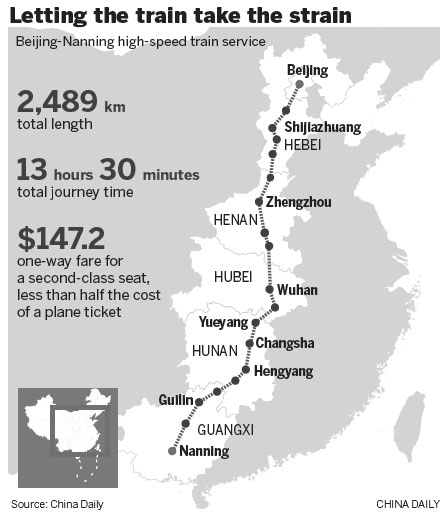
A new service is providing the first express link between Beijing and a badly disadvantaged area. The service, primarily designed to aid the development of the Guangxi Zhuang autonomous region, has been successful so far, and there are now plans to extend its coverage, as Huo Yan and Xin Dingding report from Nanning.
A high-speed rail network that stretches almost 2,500 kilometers across a single country is not a common phenomenon.
In Japan, such a network would be impossible - the train would simply have to pull up at the island nation's Pacific coast - and in Europe, pan-continental high-speed railways have yet to take shape, although many European countries have built their own networks.
In September, a high-speed rail service opened between Beijing and Nanning, the capital of the Guangxi Zhuang autonomous region, a distance of 2,489 km. The line is now the longest in China, and makes Guangxi the first of the country's five autonomous regions to be linked to the capital by high-speed rail.
Guangxi, in South China, is home to 12 ethnic groups. The region borders Vietnam, and its long coastline with Southeast Asia means it's regarded as a major gateway to member countries of the Association of Southeast Asian Nations.
Despite those advantages, more than 30 years after the start of the reform and opening-up policy Guangdong province has become China's economic powerhouse, while Guangxi's GDP is worth just a fifth of that of its smaller neighbor.
Poor infrastructure
Many observers have blamed the disparity on the region's immature transport infrastructure, which was so poor that before December, there were no direct rail connections between Nanning and nearby Guangzhou, the capital of Guangdong. Every year as the Spring Festival holiday approached, the expressways would be clogged with hundreds of thousands of migrant workers riding motorbikes from their workplaces in Guangdong to their homes in Guangxi.
Now, things are changing and a high-speed railway network is being planned that would crisscross China's 9.63 million square kilometers of territory. An extended network of this type would enable passengers to zip between major cities such as Beijing, Shanghai and Guangzhou and other parts of the country within half a day.
The ambitious plan has already been realized in Guangxi, where more than 1,000 km of high-speed rail came into use in 2013. Now, the trip from Beijing to Nanning takes 13 hours and 30 minutes, cutting the journey time by half. Passengers can depart from North China in the morning, and arrive in South China in the evening.
The streamlined train departs Beijing West Railway Station at 7:30 am and initially uses the Beijing-Guangzhou high-speed line, reaching a top speed of 300 km/h. When the train reaches Hengyang in Hunan province, it slows to a maximum 200 km/h and switches track to the Hengyang-Liuzhou line. The last change in the journey comes when the train switches again, this time to the Liuzhou-Nanning high-speed line.
Although the journey time has been cut by almost half, frequent station stops - approximately one every 30 minutes - nullify the advantages offered by the high speeds the train can attain.
Puffing on the platform
The frequent stops may annoy some passengers, but one group is eternally grateful. Smoking is banned in the trains, but the regular stops - which can last from two minutes to eight - mean heavy smokers flood out onto the platforms as soon as the train pulls up.
Zhou Xiang, who has worked on the new line since it was launched, has heard many smokers complain about how challenging they find the journey.
On slower trains, passengers can smoke in the door wells of the carriages, but smoking is banned everywhere on high-speed trains. According to the railway police in Nanning, 106 passengers were fined for smoking on the train last year.
"You can see them quickly lining up by the door when the train begins to slow down (for a stop). They always have a cigarette between their lips and a lighter in one hand. (They are) just like soldiers lining up with their weapons before going to the front," Zhou said.
Some of the more desperate smokers have even sparked arguments with the train attendants as they attempted to get out of the carriage as quickly as possible to make the most of each short stop.
On May 26, a passenger on train G529 tried to force the attendant to stand behind him so he could stand directly in front of the door and be the first passenger to disembark. His argument was "first come, first served", but he eventually relented when the attendant explained that she was duty bound to stand in front of the doors as the train comes to a halt to keep a watch for any obstructions or other activity on the platforms.
However, it's not just smokers who jump on and off the train. Five drivers work in relays during the long journey, said Wei Richun, a senior official at the Nanning Railway Bureau.
Just as safety regulations mean the working hours of commercial pilots are strictly regulated, with a team of two limited to 14 hours a day, drivers of high-speed trains are not allowed to be at the controls for more than three hours at a time, Wei said.
The drivers work for the four railway bureaus that administer the areas through which the train travels. A driver from the Beijing Railway Bureau is behind the wheel between Beijing and Zhengzhou in Henan, where another driver, this time from the Zhengzhou Railway Bureau, takes over until the train reaches Wuhan in Hubei province. The Wuhan Railway Bureau provides the next driver, who operates the train until Changsha in Hunnan province, when a driver sent by the bureau in Nanning takes over. He drives the train to Guilin in Guangxi, where a second driver is waiting to take the controls for the final leg of the journey to Nanning.
After resting for several hours in purpose-built apartment buildings, the drivers begin their journeys again, this time in the opposite direction, and return home.
While the drivers work short shifts, conductors and attendants such as Zhou have to stay at their posts throughout the entire journey, without taking a break.
"We feel under much greater pressure now than when we worked on the slower trains, because we used to work set times, and after an eight-hour stretch, we could take a break in our cabin. Now though, there's just no place or time to rest," he said.
The pressure is heightened by the fact that the assistants and guards have to deal with any emergencies that might arise on the high-speed trains, which each cost more than 100 million yuan ($16 million), he said.
Price/time balance
Although the long journey can be tedious, many passengers said the high-speed rail provides the best balance of time and cost.
A young mother from Luoyang, Henan province, who was taking her 11-month-old baby to Nanning to visit her husband and father-in-law who sell furniture in the city, said she cannot afford to travel by air.
Although the flight between Beijing and Nanning only takes about three hours, the ticket price of 1,800 yuan is nearly twice that of the high-speed rail service.
The woman, who preferred not to give her name, said she was relieved when the high-speed train was launched because the previous rail services were inconvenient.
"We used to get on a Nanning-bound train at Zhengzhou railway station at midnight, and get off at 5 the next morning," she said. "It would be torture to take the baby to Nanning that way."
Yang Hao, a professor of rail transportation management at Beijing Jiaotong University, said that the railway will provide a good supplement to air travel because the trains stop at a large number of small cities and towns that airlines won't visit because it's not economically viable for them to do so.
According to Wei, the railway official in Nanning, tourism in Guangxi has been boosted by a large rise in the number of people taking short trips on the train to local stations.
Several years ago, a friend invited Wei to attend his child's wedding in Guilin, but Wei declined because the journey would take four hours.
Now, the high-speed railway has cut the travel time to just two hours and 30 minutes. "If people leave in the early afternoon they can make a wedding banquet in the evening and then return home on the last train," he said. "If I was asked again I certainly wouldn't decline the invitation."
Contact the writers at huoyan@chinadaily.com.cn and xindingding@chinadaily.com.cn

|
A high-speed train crosses a bridge in Yangshuo in the Guangxi Zhuang autonomous region. China's longest high-speed railway service, which links Beijing and Nanning, capital of the Guangxi, is 2,489 kilometers in length. Guangxi is the first of China's five autonomous regions to be linked to the capital by high-speed rail. Tang Yizhi / for China Daily |
|
Passengers in Nanning taking a high-speed train for Beijing when the railway opened in September. Chen Fuping / for China Daily |
|
A girl points at scenery along the Beijing-Nanjing high-speed rail line. Guangxi is a major gateway between China and ASEAN countries. Chen Fuping / for China Daily |
(China Daily 06/23/2015 page5)








